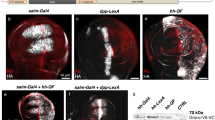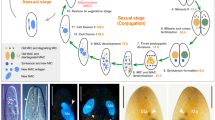Abstract
Bacteriophage φC31 encodes an integrase that can mediate the insertion of extrachromosomal DNA into genomic DNA. Here we show that the coinjection of mRNA encoding φC31 integrase with plasmid DNA encoding the green fluorescent protein (GFP) can be used to generate transgenic X. laevis embryos. Despite integration into the genome, appropriate promoter expression required modification of the reporter plasmid by bracketing the GFP reporter gene with tandem copies of the chicken β-globin 5′ HS4 insulator to relieve silencing owing to chromatin position effects. These experiments demonstrate that the integration of insulated gene sequences using φC31 integrase can be used to efficiently create transgenic embryos in X. laevis and may increase the practical use of φC31 integrase in other systems as well.
This is a preview of subscription content, access via your institution
Access options
Subscribe to this journal
Receive 12 print issues and online access
$259.00 per year
only $21.58 per issue
Buy this article
- Purchase on Springer Link
- Instant access to full article PDF
Prices may be subject to local taxes which are calculated during checkout



Similar content being viewed by others
References
Kroll, K.L. & Amaya, E. Transgenic Xenopus embryos from sperm nuclear transplantations reveal FGF signaling requirements during gastrulation. Development 122, 3173–3183 (1996).
Sparrow, D.B., Latinkic, B. & Mohun, T.J. A simplified method of generating transgenic Xenopus. Nucleic Acids Res. 28, E12 (2000).
Thorpe, H.M., Wilson, S.E. & Smith, M.C. Control of directionality in the site-specific recombination system of the Streptomyces phage φC31. Mol. Microbiol. 38, 232–241 (2000).
Thorpe, H.M. & Smith, M.C. In vitro site-specific integration of bacteriophage DNA catalyzed by a recombinase of the resolvase/invertase family. Proc. Natl. Acad. Sci. USA 95, 5505–5510 (1998).
Lutz, K.A., Corneille, S., Azhagiri, A.K., Svab, Z. & Maliga, P. A novel approach to plastid transformation utilizes the φC31 phage integrase. Plant J. 37, 906–913 (2004).
Groth, A.C., Olivares, E.C., Thyagarajan, B. & Calos, M.P. A phage integrase directs efficient site-specific integration in human cells. Proc. Natl. Acad. Sci. USA 97, 5995–6000 (2000).
Chalberg, T.W., Genise, H.L., Vollrath, D. & Calos, M.P. φC31 integrase confers genomic integration and long-term transgene expression in rat retina. Invest. Ophthalmol. Vis. Sci. 46, 2140–2146 (2005).
Thyagarajan, B., Olivares, E.C., Hollis, R.P., Ginsburg, D.S. & Calos, M.P. Site-specific genomic integration in mammalian cells mediated by phage φC31 integrase. Mol. Cell. Biol. 21, 3926–3934 (2001).
Thomason, L.C., Calendar, R. & Ow, D.W. Gene insertion and replacement in Schizosaccharomyces pombe mediated by the Streptomyces bacteriophage φC31 site-specific recombination system. Mol. Genet. Genomics 265, 1031–1038 (2001).
Olivares, E.C. et al. Site-specific genomic integration produces therapeutic Factor IX levels in mice. Nat. Biotechnol. 20, 1124–1128 (2002).
Held, P.K. et al. In vivo correction of murine hereditary tyrosinemia type I by φC31 integrase–mediated gene delivery. Mol. Ther. 11, 399–408 (2005).
Belteki, G., Gertsenstein, M., Ow, D.W. & Nagy, A. Site-specific cassette exchange and germline transmission with mouse ES cells expressing φC31 integrase. Nat. Biotechnol. 21, 321–324 (2003).
Groth, A.C., Fish, M., Nusse, R. & Calos, M.P. Construction of transgenic Drosophila by using the site-specific integrase from phage φC31. Genetics 166, 1775–1782 (2004).
Vize, P.D., Melton, D.A., Hemmati-Brivanlou, A. & Harland, R.M. Assays for gene function in developing Xenopus embryos. Methods Cell Biol. 36, 367–387 (1991).
Newport, J. & Kirschner, M. A major developmental transition in early Xenopus embryos: II. Control of the onset of transcription. Cell 30, 687–696 (1982).
Kuhn, E.J. & Geyer, P.K. Genomic insulators: connecting properties to mechanism. Curr. Opin. Cell Biol. 15, 259–265 (2003).
West, A.G., Gaszner, M. & Felsenfeld, G. Insulators: many functions, many mechanisms. Genes Dev. 16, 271–288 (2002).
Bell, A.C. & Felsenfeld, G. Stopped at the border: boundaries and insulators. Curr. Opin. Genet. Dev. 9, 191–198 (1999).
Chung, J.H., Whiteley, M. & Felsenfeld, G. A 5′ element of the chicken β-globin domain serves as an insulator in human erythroid cells and protects against position effect in Drosophila. Cell 74, 505–514 (1993).
Pikaart, M.J., Recillas-Targa, F. & Felsenfeld, G. Loss of transcriptional activity of a transgene is accompanied by DNA methylation and histone deacetylation and is prevented by insulators. Genes Dev. 12, 2852–2862 (1998).
Offield, M.F., Hirsch, N. & Grainger, R.M. The development of Xenopus tropicalis transgenic lines and their use in studying lens developmental timing in living embryos. Development 127, 1789–1797 (2000).
Smith, M.C., Burns, R.N., Wilson, S.E. & Gregory, M.A. The complete genome sequence of the Streptomyces temperate phage straight φC31: evolutionary relationships to other viruses. Nucleic Acids Res. 27, 2145–2155 (1999).
Hollis, R.P. et al. Phage integrases for the construction and manipulation of transgenic mammals. Reprod. Biol. Endocrinol. 1, 79–89 (2003).
Rebagliati, M.R., Weeks, D.L., Harvey, R.P. & Melton, D.A. Identification and cloning of localized maternal RNAs from Xenopus eggs. Cell 42, 769–777 (1985).
Dagle, J.M., Walder, J.A. & Weeks, D.L. Targeted degradation of mRNA in Xenopus oocytes and embryos directed by modified oligonucleotides: studies of An2 and cyclin in embryogenesis. Nucleic Acids Res. 18, 4751–4757 (1990).
Nieuwkoop, P.D. & Faber, J. Normal table of Xenopus laevis (Daudin): a systematical and chronological survey of the development from the fertilized egg till the end of metamorphosis. (Garland Pub., New York, 1994).
Acknowledgements
We thank M. Calos, G. Felsenfeld and P. Krieg for their generosity in providing plasmids used in this study. We thank H. Bartlett, J. Dagle, S. Kolker, C. Fett, E. Hornick and E. Stokasimov for helpful discussions. Funding to D.L.W. from the National Institutes of Health (GM069944 and DC007481) supported this work. B.G.A. is a student in the Medical Scientist Training Program at the Roy J. and Lucille A. Carver College of Medicine, University of Iowa.
Author information
Authors and Affiliations
Corresponding author
Ethics declarations
Competing interests
B.G.A. and D.L.W. are authors of a provisional patent application that has been filed related to the use of insulated genes and attB contained in plasmids.
Rights and permissions
About this article
Cite this article
Allen, B., Weeks, D. Transgenic Xenopus laevis embryos can be generated using φC31 integrase. Nat Methods 2, 975–979 (2005). https://doi.org/10.1038/nmeth814
Received:
Accepted:
Published:
Issue Date:
DOI: https://doi.org/10.1038/nmeth814
This article is cited by
-
Protein trap: a new Swiss army knife for geneticists?
Molecular Biology Reports (2020)
-
Modeling Dominant and Recessive Forms of Retinitis Pigmentosa by Editing Three Rhodopsin-Encoding Genes in Xenopus Laevis Using Crispr/Cas9
Scientific Reports (2017)
-
Dual promoter expression system with insulator ensures a stringent tissue-specific regulation of two reporter genes in the transgenic fish
Transgenic Research (2013)



